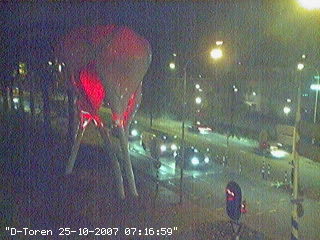Project: D-Tower
Architect: Lars Spuybroek (NOX)
Artist: QS Serafijn
Location: Doetinchem, The Netherlands
Date: 1998-2004
"The D-Tower is a project where the intensive (feelings, qualia) and the extensive (space, quantities) start exchanging roles, where human action, color, money, value, feelings all become networked entities."
-Lars SpuybroekBlue = Happiness
Yellow = Fear
Green = Hate
Red = Love
The 15 meter tall "bulbous, vegetal" tower produces emotion through symbolic colors. Depending on responses by the 45,000 people of Doetinchem to a questionnaire written by the project's artist, Serafijn, the lamps contained inside the epoxy structure change colors.
Each night after the questions have been answered for the day, the Tower transmits "the State of the Town" by emitting the color associated with the emotion. At the beginning of each month, a new set of narrowed questions are added each pertaining to human emotions: Happiness, Fear, Hate and Love. All the answers create an "Emotion Landscape" which maps out the emotions of the city.
Three components make up the artwork: "a website (accessible to everybody), a questionnaire (accessible to a hundred different people each year that have a special password) and a Tower" linking all three parts together. They post a web cam for a continuous update on the structure.
 Image: Arcspace.com, NOX
Image: Arcspace.com, NOXBeing a prefabricated structure precise modeling and effort went into the Tower's realization. The epoxy panels of the tower were created from milled styrofoam. The panels aren't all unique pieces as they may seem, but actually "some panels repeat four times, others two or three" which allows these non-standard geometry to be affordable without having to redesign them to basic flat planes and cilinders.
 Image: ArcSpace.com, NOX
Image: ArcSpace.com, NOXStress Analysis
The structure also links to the past Gothic Vaults in its surface and columns sharing the same continuum. (noxarch.com)
Sources/Links:
noxarch.com
ArcSpace.com(Design)
ArcSpace.com(Built)
D-Toren.nl
Bullivant, Lucy. Architectural Design. John Wiley & Sons Ltd Co. 2005.
Vol. 75 No. 1, Jan/Feb 2005. pg. 68-69













